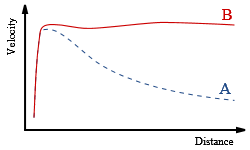
Comic Transcript
Panel 1.
Alkina: Dr. Rubin, did you study galaxy clusters like Fritz Zwicky?
Vera: No, I studied individual galaxies, not galaxy clusters.
Panel 2.
Vera: With Kent Ford’s spectrometer, I measured the orbital velocities of stars within galaxies. We all expected to find slower stars as we looked farther out from the galaxies’ centers.
Epo: Because objects that are farther from a central mass should have slower orbital velocities.
Vera: Right, as per Kepler’s 3rd law of planetary motion and Newton’s Law of Universal Gravitation. But we didn’t find that.
Panel 3.
Vera: What we found was that the outer stars were traveling just as fast as the inner stars.
Alkina: If they were going that fast, wouldn’t they fly out of the galaxy!?
Panel 4.
Vera: Yes, at their velocities they should escape the gravitational pull of the galaxy. But they don’t. Which means there is more mass in galaxies, and around galaxies, which is keeping the stars in the galaxies. But we can’t see it…it’s dark matter.
What does it mean?
Kepler’s 3rd law of planetary motion – The square of the period (P) of an object’s orbit is proportional to the cube of the semi-major axis (a) of that orbit. Mathematically, this can be represented as P2 ∝ a3. Kepler discovered this law by studying the motions of the planets around the Sun, but it is a fundamental law that can be derived from Newton’s Law of Gravitation.
Newton’s Law of Universal Gravitation – Two objects with masses m1 and m2 that have a distance r between their centers attract each other with a force equal to (G*m1*m2)/r2. The Universal Gravitational Constant, G,
is equal to 6.672×10-11Nm2/kg2 in SI units.
In human speak please!
Vera Rubin studied the orbital velocities of stars in galaxies. Kepler’s and Newton’s laws predicted that a star at the edge of a galaxy should move more slowly around the center mass of the galaxy than stars that were closer. But even accounting for all the visible mass in galaxies, Dr. Rubin repeatedly found that the distant stars were orbiting at speeds comparable to those near the center of the galaxy.
This was the case for every galaxy Dr. Rubin looked at, and has been confirmed by many other astronomers since her initial discoveries. The implication of these findings is that not only do galaxies contain more mass than can be seen, but the invisible mass resides far outside of the visible portion of the galaxy.
Putting Kepler’s Third Law and Newton’s Law of Gravitation together leads to the curve labeled as A in the figure below, with the more distant stars having lower velocities. But this is not what is seen in galaxies. Instead, the velocity remains constant out as far as stars can be seen. Line B is what is actually seen – distant stars have nearly the same velocity as closer stars.

